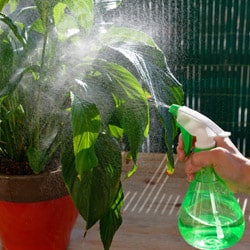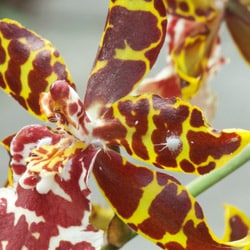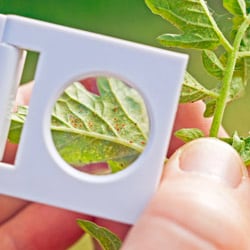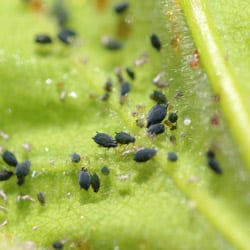Most Common Houseplant Pests and How to Control Them
It’s not unusual for houseplants to become infested with different pests, but with conscientious care, even the most tenacious pests can be controlled. By acting quickly when pests are first noticed, you can completely remove the infestation and keep your houseplants healthy and thriving.
Top 5 Common Houseplant Pests and Controlling Them
Different plants may be susceptible to different types of pests depending on your home’s environmental conditions and the plants’ overall health. These pests, however, are the most widespread houseplant pests….
Fungus Gnats
These tiny, flying pests don’t do any harm to houseplants in their mature, adult form, but fungus gnat larvae live in houseplant soil and feed on organic material. This not only robs the plant of nutrition, but the larvae may nibble on the plant’s roots as well. While they don’t cause much overall damage to an otherwise healthy plant, fungus gnats can be very irritating when they form cloud-like flocks around a plant’s foliage.
Overwatering in rich soil encourages fungus gnats, and they can be notoriously difficult to eradicate. Reducing watering so the top 1-2 inches of soil can dry out is the first step, but it is often best to completely repot an infested plant. The roots should be rinsed carefully to remove any lingering larvae, and if the same pot will be reused, it must be sterilized first. Use well-draining soil or water the plant from the bottom to make the soil less attractive to fungus gnats. You may also mix diatomaceous earth into the soil to deter these pests, add additional perlite to the soil to increase drainage, use a fine gravel top dressing, or apply a mosquito plant drench to organically kill fungus gnat larvae.
Mealybugs
These sap-sucking insects are no more than a half-inch long and have a white or light gray fluffy appearance. They are typically seen along the stems of houseplants, especially in the joints where foliage sprouts. As they suck the plant’s sap, the leaves wither and wilt. Yellowing leaves can also be another sign of a mealybug infestation, particularly if leaves are yellowing throughout the plant rather than just older bottom foliage.
When a houseplant is heavily infested with mealybugs, the fastest way to control the pests is to prune away infected foliage and discard of it carefully. If the infestation is light, however, the bugs can be deterred with a Neem oil spray or rubbing alcohol. Apply the alcohol directly to the pests with a cotton ball or swab to kill them.
Spider Mites
These pests can be very destructive to all houseplants and can be challenging to get rid of. The mites themselves are so tiny that they may not be noticeable even with a heavier infestation, but their webs on the undersides of foliage or stretching between stems will be easier to see. Leaves that show yellow stippling may also indicate a spider mite infestation.
Spider mites thrive in dry conditions, so keeping houseplants’ humidity high is a good way to deter them. Running a humidifier, frequent misting, grouping pots together, and sitting pots on water filled pebble tray are all helpful solutions. When the bugs are present, neem oil spray should be used weekly to remove them and keep them from returning. Alternatively, light cleaning with insecticidal soap is also an effective way to control spider mites.
Aphids
While better known for their outdoor infestations, aphids can also be a problem on indoor houseplants. They are tiny insects, no more than one-eighth of an inch in size and range from green or black to reddish or white. They are very plump insects and get that way as they suck sap from the plant, usually on the foliage or stems. The plant will gradually wilt as it is unable to stay firmly upright while the aphids drain its sap.
Aphids are easily dislodged with a blast of water, so a cleansing shower is a good way to remove many of these pests without any unnecessary chemicals. If the infestation is extreme, it may be necessary to wash the plant gently with an insecticidal soap to get rid of aphids. Neem oil spray can also be effective for controlling aphids on houseplants.
Scale
These insects have a hard, oval-shaped shell that gives them a tough, scale-like exterior as they line up on a plant’s stems in tight clusters, similar to barnacles on a boat’s hull. These pests suck sap from the plant, and then produce a sticky, honeydew residue that can coat the plant and lead to mildew or may attract additional pests.
Your first line of defense is to gently scrape scale bugs off a plant with your fingernail, taking care not to scratch or damage the already stressed plant. Dabbing the insects with swab soaked in rubbing alcohol or spraying with neem oil can also be effective.
Minimizing Houseplant Pests
No matter which pests may be a problem, it’s always best to avoid infestations altogether rather than try to control them after the insects have already made an appearance. To minimize the risk of bugs taking over your houseplants…
- Purchase new plants only from a reputable retailer, like Strader’s Garden Center that offers proper care to the plants and can offer support for any problems after purchase.
- Inspect new plants carefully before purchasing and avoid plants with signs of pests.
- Quarantine any new plant for at least a week to be sure it doesn’t have any unwanted guests, including outdoor summer plants that will overwinter as houseplants.
- Use high quality, well-drained potting soil for all houseplants, rather than garden soil that isn’t sterilized and can even harbor pests.
- Provide houseplants with optimum care so they are not stressed as stress can make them more susceptible to pest infestations.
- Sterilize all houseplant equipment regularly, including pots that will be reused, pruners and shears, and watering cans, to be sure no pests are carried between plants.
- Stay alert at all times for signs of possible insect infestations. The faster you are able to act, the easier it will be to control these unwanted guests.
It can be frustrating to find pests on your houseplants, but with careful monitoring and appropriate control measures, your plants will soon be pest-free.
















